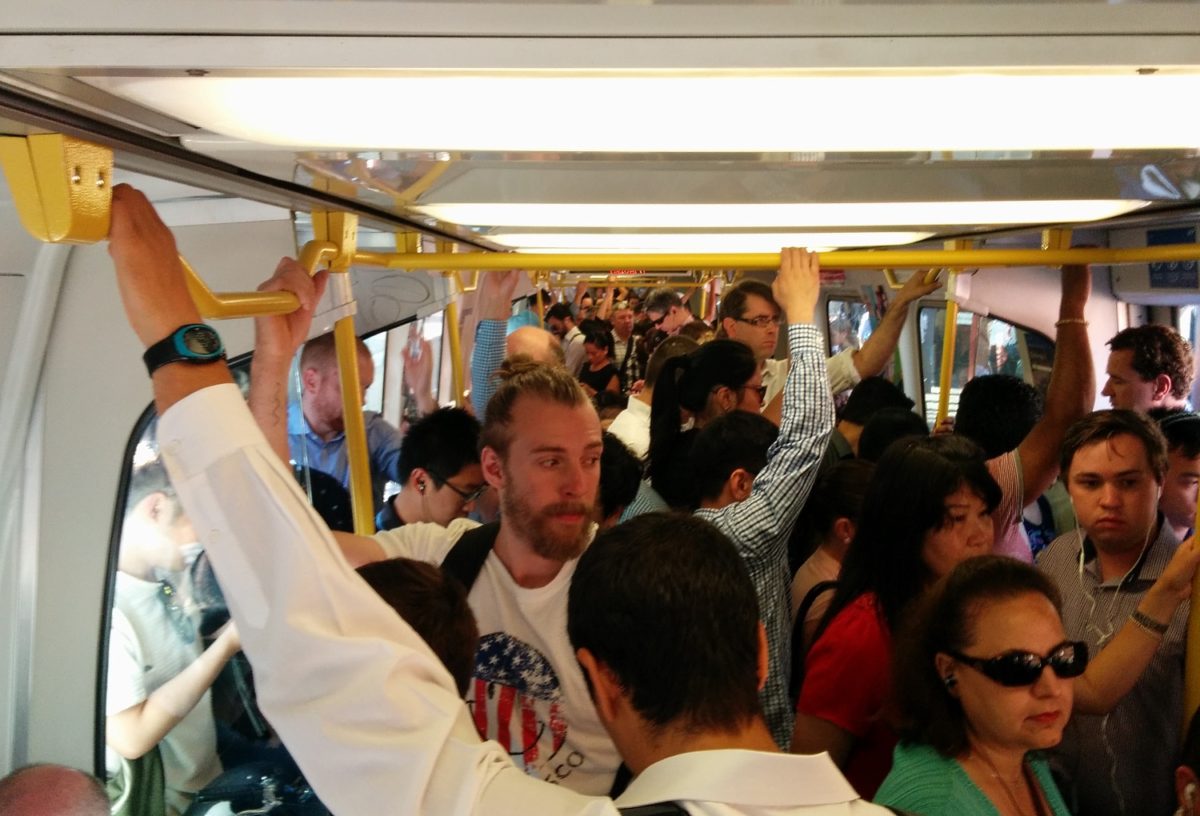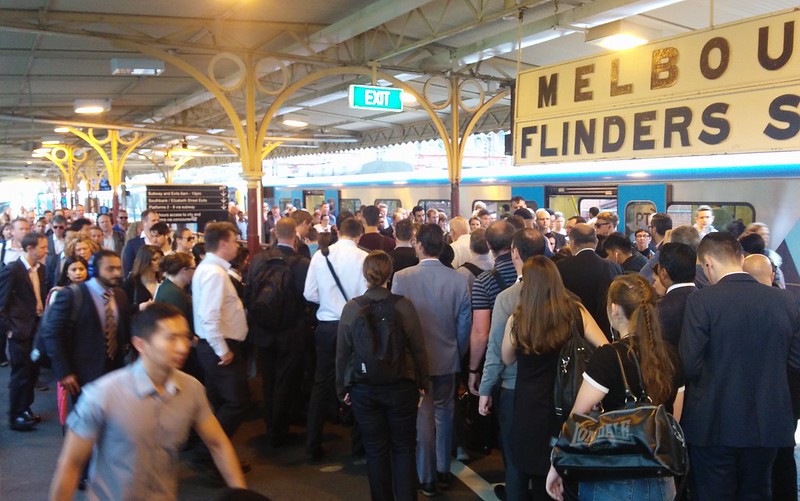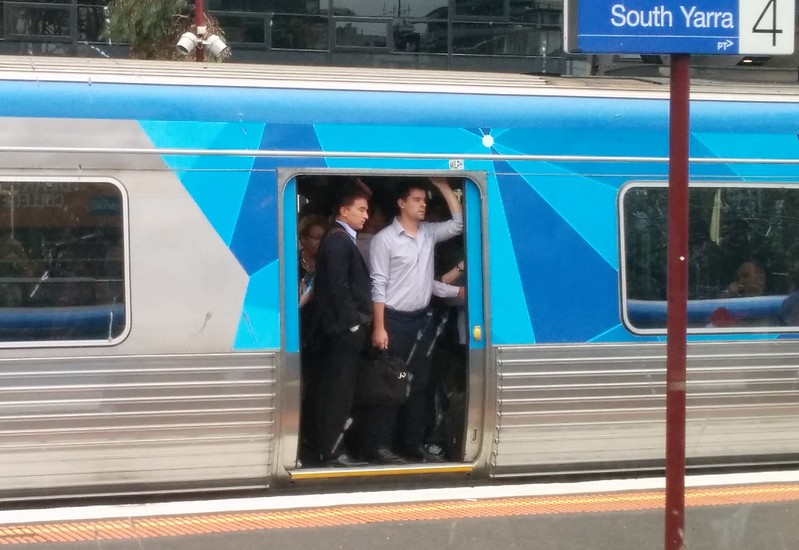If you missed the front page story in today’s Age: Melbourne to go more than two years without a peak-hour train timetable boost
See also: PTUA: Services packed while seven trains sit idle – where is the new timetable?
To recap: Regional Rail Link separated out most V/Line services from Metro services, giving V/Line trains on the Geelong, Ballarat and Bendigo lines a better run into Melbourne… but also freeing up space for more Metro services on the Sunbury, Williamstown and Werribee lines.
How many more Metro services did RRL allow? 23 per peak according to the literature.
How many of those 23 are used? One per peak, on the Werribee line.
While nobody expects all the capacity to be used straight away, we expect better than this in a growing city.
A much larger number of new services were part of a broad package benefiting a number of lines.
It appears the package was deferred because of a reluctance to remove remaining peak Frankston trains from the City Loop, which was a key part of the planned timetable.
Perhaps this is understandable given there was no immediate plan to fill those slots with more Dandenong trains. That can’t happen until level crossings are removed between Caulfield and Dandenong.
But a year later, what is happening? Are they working on a revised plan to bring in the extra services? We don’t know. And it must be well over a year since it was flagged within government that the changes would be deferred.
Meanwhile, consider these recent developments…
Since the last big timetable change in July 2014, eight trains have come into service, with only one used. Five more are on order.
The 2016 Budget papers claim 94% Metro rolling stock availability, but VicSig indicates only 185 out of 209 trains (88.5%) are actually used at the busiest time of day.
The May 2015 load survey showed load breaches (overcrowding) increased from 41 to 47 from 2014. The worst appeared to be:
- Dandenong AM 9/PM 7
- Sunbury AM 7/PM 6
- Werribee AM 8/PM 9
Bear in mind the zone 1+2 fare changes that took effect in January 2015 would have had a big effect on the longer lines, but thanks to PTV cutbacks there’s now only one load survey per year, and the May 2016 results aren’t out yet… so we don’t know precisely what the picture is now.
December 2015 figures showed Metro patronage up 3.5% in twelve months.
In comparison to this growth, the 2016 Budget figures showed expected Metro service kilometres up only 0.9% for year ending June 2016, compared to the previous year.
The ABS says Greater Melbourne population growth is about 2.1% per year.
Crowding on the busiest part of the rail network is largely the result of CBD activity, particularly workers and students who mostly travel in peak hour. City Of Melbourne figures show 1.5% annual growth in the daily city population, with city workers expected to increase by about 2% annually in the near future.
Population growth versus rail service growth
Greater Melbourne and specifically the central business district and inner suburbs keep growing.
Getting people to employment and education is vital; it’s what drives the economy, and continued prosperity, and only mass transit can do it efficiently in a dense and thriving urban area like inner Melbourne.
It’s great that the government is pushing ahead with projects like the Melbourne Metro Rail Tunnel, and level crossing removals, and the now-completed Regional Rail Link, high-capacity train fleets and high-capacity signalling, all of which provide a capacity boost for extra services… but we also need to actually see those extra services provided.
- Related: Urban.Melbourne notes the importance of a service plan, not just infrastructure





12 replies on “Extra track and fleet capacity is great! But what about extra services?”
Very disappointing. It’s great to be able to announce huge capital expenditures, but if we have capacity to run more trains now – we should be doing that.
This also ties in with how the changes associated with the PTV Rail Plan have been derailed – there’s an older blog post on the plans they had, much of a the network would start receiving much more useful turn-up-and-go services by 2016 in off-peak, and increases across the network for peak. As has been mentioned plenty of times, these changes don’t require a cent of capital expenditure to put into action. Extra trains may be required for the peak improvements, but as we can see, the fleet has been expanded without actually being utilised.
It’s fantastic a big capital project is underway, to be honest, however, the delays with the rolling out of actual improvements don’t give me much confidence in the handling actual provision of services. We spent near $5bn on a huge project to enable boosted services for busily growing areas – that is $5bn down the drain if no significant service improvements come out of it.
As mentioned in previous blog posts, the Liberal government costed doubling inter-peak service to South Morang in the low millions of dollars a year (the figures aren’t clear). Multiply this a few times for lines across the network, and that is still a very small price to pay compared with the enormous megaprojects that are taking place.
If service improvements are in the pipeline, let us know. Let us know if there is a real plan to improve services across the network so we don’t decide to set down for the second or third car, so we can find places to live where the service will be adequate.
I wonder if the Frankston line will revert to the pre-level crossing removal timetable once Moorabbin – Caulfield reopens, or will this be delayed too?
As first-hand proof of this issue, I in my electric wheelchair have had to wait at Carnegie Train Station in the cold & watch as many as 7 trains go through with commuters packed in “like sardines in a can” before a driver could put me on to head into the city. YES, we need Extra Services & NOW not in 2-3 years time – the problem will only worsen as Melbourne’s population grows, unfortunately I’m not holding my breath, if I did I’d die of a lack of oxygen.
As a 30 year commuter from Huntingdale, I’ve given up trying to get a seat. I specifically target the three AM Westall services these days, travelling back down the line to Westall on the turnaround train. Much more comfortable. They are starting to advertise these Westall trains at Clayton (“train with a seat coming in 3 minutes”).
Does this simply highlight the problem with the complexity and interconnectedness of our rail system, whereby a major timetable overhaul takes well over a year to implement?
@Campbell, 2016 is not over yet! I’m hopeful that we will still see 10-minute services on more lines by the end of the year, in line with the PTV plans.
You can’t and shouldn’t have all your trainsets in use for the peak. I seem to remember reading somewhere 15% would be typically spare. In Melbourne’s case, train sets not running would include sets being serviced, hot spares to replace faulty sets, and ones allocated for race and football specials etc. The number of faulty sets is probably relatively higher in Melbourne due to the poor condition of some of the Comeng carriages and the chronic graffiti problem. I don’t know exactly what the operator thinks is appropriate for the number of spare sets but I think you should have found out from them before criticising them publicly.
As a train traveller, I’d actually prefer a crowded service that arrives than random cancellations. Random cancellations is what you get when you don’t have enough spare sets.
I seem to recall it was the Ballieau/Napthine government that delayed ordering new trains while RRL was being built. If true, it would have been like buying a new printer and no ink.
Some of the Comeng carriages are in a shocking state. In particular they give off a high-pitched whine from the roof that’s unbearable for anyone with normal hearing. They should not be in service in their current state.
Finally, removing Frankstons from the loop is a grossly unfair solution if there isn’t room to change onto loop trains at Richmond or Caulfield. Why should people who bought a house decades ago in a suburb with a good service lose it in favour of places that weren’t even in Melbourne back then?
@Campbell, that’s right, a lot of the good stuff in the PTV Network Development Plan, especially 10 minute services, hasn’t happened as fast as people would like. Of course it’s tied to things like the funding of maintenance facilities and driver recruitment.
@nick, initially when the line re-opens, only two tracks will be in operation, so it’ll be the same temporary all-trains all-stops timetable we’ve had all of this year. A month or two later the third track will re-open and presumably express trains will resume (though as you’d guess, I quite like the all-trains all stops timetable).
@Phill, I saw another gentleman in a wheelchair patiently waiting with a Metro staffer at South Yarra the other day. Hopefully he didn’t have to wait too long for a train to squeeze aboard.
@Rick, certainly the current complexity of the system doesn’t help. Notice they managed to adjust the Sandringham timetable during the Frankston line works – no doubt because the Sandringham line is pretty much independent of the others on weekdays.
As it stands, on weekdays the Frankston, Cranourne/Pakenham, Werribee, Williamstown lines are all connected. And some Craigieburn direct trains share tracks with Werribee/Williamstown, meaning there are indirect links also to the Sunbury, Craigieburn and Upfield lines.
@Francis, I’d appreciate a cite on the supposed requirement of 15% of trains spare. As the blog post says, it’s the government (in concert with Metro) claiming they’ve achieved 6%, but actually they seem to have 11% spare. That aside, as per the blog post, since the last big timetable change they’ve added another 8 trains and only used 1.
The number of spare trains appears to be highly dependent on individual characteristics of the fleet and systems they are a part of. This paper (see pages 5-10) notes Spare Vehicle Ratios in North America as low as 3.5%, but as high as 79%!
Note there are almost no Race/Football specials that run during peak hours. Oaks Day is the major exception. Some Friday night football trains run before games; these ramp up just as outbound peak trains normally go back into stabling, so they don’t add much extra stress to the system.
Obviously if more trains run direct to Flinders Street, then more trains have to be provided overall to cope with those that have to change. In fact it’s these changes that enable more trains overall. The same debate was had on the Sandringham in the 90s and the Werribee line in the 2000s, but today they carry more people than ever.
Your closing remark reminds me of the “Now that I’m here, nothing else must change” perspective. Cities aren’t like that. They evolve, and so do their transport systems.
Daniel, 94% availability means 6% of trains are either being serviced or awaiting repair. This is not the number of trains available for timetabled service.
You still need spare trains for those that are *about* to go faulty, and how many that is depends on the *rate* faults occur and the network topology. For example, if trains break often and are fixed quickly you’ll need more hot spares than if they break rarely, even if those rare breakages take a long time to fix. Spares are also useless if too far out of position. And, if you have 6 sets on a disconnected (because of LX removal) part of the network, you still need 1 whole spare set down there (not 0.7 of a set…) and maybe more, because you can’t get any of them to Newport for repair.
The actual number depends on the fleet and the network, and should be determined using operations research techniques. The airlines do this, because one aircraft out of position can cost hundreds of thousands of dollars.
I wish I could remember where I read the 15% – probably somewhere on the voluminous London Reconnections site. But I can’t see how the table in the paper you posted in any way contradicts that figure.
Melbourne does not deserve to be ranked highly in any liveability study when it has such appalling transport.
Would the Frankston line be better served by a tiered service during off-peak daytime hours ? At just over an hour, it is a long slow trip stopping all stations. An outer tier could operate every 20 minutes stopping all stations from Frankston to Southland, after which it could use the third track and save 11 minutes as a semi-express stopping only at Caulfield and South Yarra (assuming 1 minute per station). An inner tier could run every 10 minutes between the turn-back facility at Cheltenham, stopping all stations to Flinders St.. With a net time saving of the semi-express services even when waiting time in included, patrons on the outer tier may be happy with a 20 minute service as a way of funding the additional service hours in order to get a semi-express service.
An outer tier service frequency of less than 20 minutes wouldn’t work easily, because of constraints on the third track. This is effectively a single track for semi-express trains, unless the counter-peak direction uses the stopping track and incurs additional travel time.
@Malcolm M, as you note, the third track (but no fourth track) would be the issue. Theoretically one can run trains up and down, alternating direction, but could it be done reliably on a 20 minute frequency, while conflicts at Caulfield, and at Moorabbin? I’m not sure.
Another option might be to run expresses inbound in the morning, outbound during the afternoon, though this would require more trains and result in a fleet imbalance during the morning!
20 minutes on the outer section would also mean a downgrade in service for local trips beyond Cheltenham, which raises the question of whether outside peak hours the focus for growing patronage should be the CBD, or encouraging trips into major suburban centres like Southland and Frankston.
(For comparison purposes: Google Maps reckons Carrum to the City takes 40 minutes by car if departing at 11am and using the Citylink tollway. 50 minutes if avoiding tolls. The train, when buses aren’t replacing services, takes 53 minutes. But I would think people probably consider parking costs and congestion in the CBD itself, as well as waiting times for a train home to be factors in their decision – not just travel time.)
Firstly, on the extra trains not being used….
… they are all Xtraps, and currently can only be used on the Burnley and Clifton Hill group, of which is 100% Xtraps now?
They can only be used to boost capacity on those groups. There are no more Comeng trains to cascade from there onto other lines.
The current plan to get Xtraps on the Franston line, that is the only hope we have, for extra Xtraps to mean extra services all over the system, and that project is not yet ready.
I guess the current order of Xtraps are getting ready for full use of them on these other lines.
SECONDLY, despite the interconnectiveness of the network, it can not be too hard to work something out. All they need, is to work out a pattern to cycle through and repeat each 10 minutes.